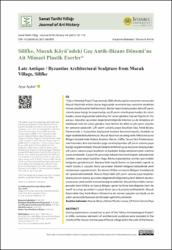| dc.contributor.author | Aydın, Ayşe | |
| dc.date.accessioned | 2022-09-22T07:55:12Z | |
| dc.date.available | 2022-09-22T07:55:12Z | |
| dc.date.issued | 2022 | en_US |
| dc.identifier.citation | Aydin, Ayse. “Silifke, Mucuk Köyü’ndeki Geç Antik-Bizans Dönemi’ne Ait Mimari Plastik Eserler”. Sanat Tarihi Yıllığı - Journal of Art
History 30 (2021), 81-110.https://doi.org/10.26650/sty.2021.863950 | en_US |
| dc.identifier.uri | https://doi.org/10.26650/sty.2021.863950 | |
| dc.identifier.uri | https://hdl.handle.net/20.500.12809/10298 | |
| dc.description.abstract | During explorations carried out as part of the "Goksu Archaeological Project" in 2006, numerous elements of architectural sculpture were recorded in the vicinity of the houses and mosque of Mucuk village and in the walls of the houses themselves. The sculpture, all of which is limestone, includes five flat pier capitals (one of which was embedded in a wall), three flat pier bases, one column base, one column shaft built into a wall, one column shaft fragment (likely belonging to a ciborium or templon given its size), and one flat pier for a window. Flat pier capitals were used in Constantinople, Anatolia, and other provinces throughout the late antique / Byzantine period, starting in the third or fourth century. Several flat pier capitals, two of Proconnesian marble, two of marble, and the rest of limestone, are on exhibition in museums (in modern Adana, Anamur, Mersin, Silifke, and Tarsus) located, like Mucuk, in the territory of ancient Cilicia and Isauria. The flat pier capitals and limestone bases, which form a group with those from Mucuk, are indicative of local production in regional workshops. The column / pier capitals, which were produced in Constantinople from the first half of the fifth century onwards were exported to various regions within the Eastern Roman Empire. Thus, different capital forms with varying leaf and motif styles began to be produced in regional workshops using local materials in the second half of the fifth century. This pattern is well demonstrated by the Cilician and Isaurian examples. The rendering of acanthus leaves on the flat pier capitals in Mucuk suggests that the style imported from the capital was adapted to reflect local tastes. It may be concluded that the architectural pieces recorded in Mucuk date to the second half of the fifth or sixth century, based on their motifs and style and by taking into account the general history of Cilicia and Isauria. Moreover, the late antique / Byzantine period architectural elements at Mucuk must be remnants of a church once located in or near the village. | en_US |
| dc.item-language.iso | tur | en_US |
| dc.publisher | ISTANBUL UNIV | en_US |
| dc.relation.isversionof | 10.26650/sty.2021.863950 | en_US |
| dc.item-rights | info:eu-repo/semantics/openAccess | en_US |
| dc.subject | Mucuk | en_US |
| dc.subject | Byzantine | en_US |
| dc.subject | Architectural Sculpture | en_US |
| dc.subject | Isauria | en_US |
| dc.subject | Flat Pier | en_US |
| dc.title | Late Antique / Byzantine Architectural Sculpture from Mucuk Village, Silifke | en_US |
| dc.item-title.alternative | Late Antique / Byzantine Architectural Sculpture from Mucuk Village, Silifke | en_US |
| dc.item-type | article | en_US |
| dc.contributor.department | MÜ, Edebiyat Fakültesi, Sanat Tarihi Bölümü | en_US |
| dc.contributor.authorID | 0000-0001-5944-6347 | en_US |
| dc.contributor.institutionauthor | Aydın, Ayşe | |
| dc.identifier.volume | 30 | en_US |
| dc.identifier.startpage | 81 | en_US |
| dc.identifier.endpage | 110 | en_US |
| dc.relation.journal | Sanat Tarihi Yıllığı - Journal of Art History | en_US |
| dc.relation.publicationcategory | Makale - Uluslararası Hakemli Dergi - Kurum Öğretim Elemanı | en_US |


















